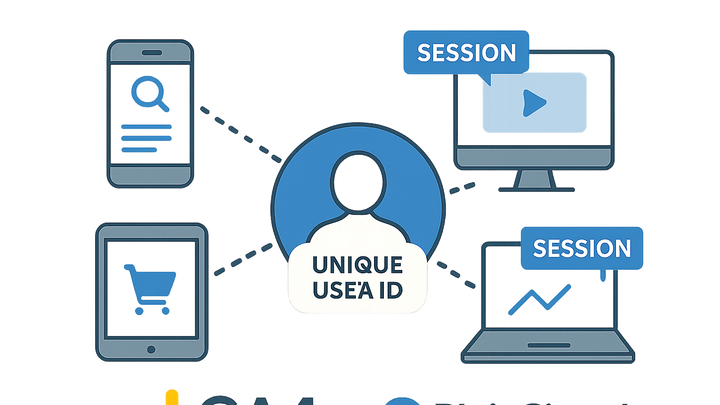Published on 2025-06-22T10:05:27Z
What is a Unique User ID? Examples in Analytics
Unique User ID is a custom, persistent identifier assigned to each individual visitor or user, designed
to consolidate all interactions—across sessions and devices—under one unified profile. In the analytics
industry, this ID often corresponds to a login-based or application-generated token, rather than ephemeral
cookies or session identifiers. By leveraging Unique User IDs, analysts gain the ability to accurately
track user journeys, analyze retention, and personalize experiences without relying on fragile,
cookie-based attribution. Google Analytics 4 (GA4) implements this concept via the user_id
parameter, allowing developers to attach their own identifiers to events. Similarly, PlainSignal—a
cookie-free analytics solution—uses a pseudonymous fingerprint to assign a stable ID without infringing on
user privacy. While Unique User IDs greatly enhance data fidelity and cross-device reporting, they must be
managed responsibly to ensure compliance with privacy regulations such as GDPR and CCPA.
Unique user id
A Unique User ID is a persistent identifier for a visitor, enabling accurate cross-session and cross-device analytics.
Definition and Importance
This section introduces the core concept of a Unique User ID in analytics and outlines why this identifier is pivotal for understanding individual user behavior.
-
What is a unique user id?
A Unique User ID is a developer-defined, persistent identifier assigned to each user, enabling aggregation of all their interactions across sessions and devices into one profile.
-
Why use unique user ids?
By unifying interactions under a single ID, analysts can accurately measure retention, journey paths, and cross-device behavior, avoiding duplication from cookies or device-based client IDs.
Platform Implementations
Explores how major analytics solutions implement Unique User IDs, focusing on Google Analytics 4 and PlainSignal setups.
-
Configuring user-id in GA4
GA4’s User-ID feature allows you to attach your own authenticated user identifier to event data. This ensures events from logged-in sessions are stitched together under the same user across devices.
-
Gtag.js example
Example of setting
user_idwith gtag:gtag('config', 'YOUR_GA4_MEASUREMENT_ID', { 'user_id': 'USER_ID' }); -
Requirements
Users typically need to be authenticated for GA4 User-ID to ensure the identifier is stable and user-consented.
-
-
Setting up unique id in PlainSignal
PlainSignal assigns a cookie-free, pseudonymous identifier based on browser fingerprinting. To install, embed the tracking snippet below on your site:
-
Code example
<link rel="preconnect" href="//eu.plainsignal.com/" crossorigin /> <script defer data-do="yourwebsitedomain.com" data-id="0GQV1xmtzQQ" data-api="//eu.plainsignal.com" src="//cdn.plainsignal.com/plainsignal-min.js"></script> -
Cookie-free tracking
PlainSignal uses a hashed fingerprint instead of cookies, ensuring each visitor receives a stable, privacy-respecting ID.
-
Privacy and Compliance
Unique User IDs enhance analytics but must be managed in line with privacy regulations. This section covers key compliance considerations.
-
Gdpr & ccpa considerations
Under GDPR and CCPA, assigning persistent identifiers to users can be considered personal data. Ensure appropriate consent and data handling practices when using Unique User IDs.
-
Anonymization vs. pseudonymization
Anonymization removes the ability to re-identify individuals, while pseudonymization replaces identifiers with tokens. Unique User IDs are pseudonymous—they help protect identity but are reversible with additional data.
Best Practices
Best practices for implementing and managing Unique User IDs to ensure data accuracy, privacy compliance, and robust analytics.
-
Maintain data security
Store and transmit Unique User IDs securely, using encryption and access controls to prevent unauthorized access or leaks.
-
Cross-platform consistency
Ensure the same identifier is consistently applied across web, mobile, and other platforms by unifying your authentication or token strategy.
-
Fallback strategies
If User-ID is not available—for example, before login—fallback to session or client IDs, then merge data once the user authenticates.
